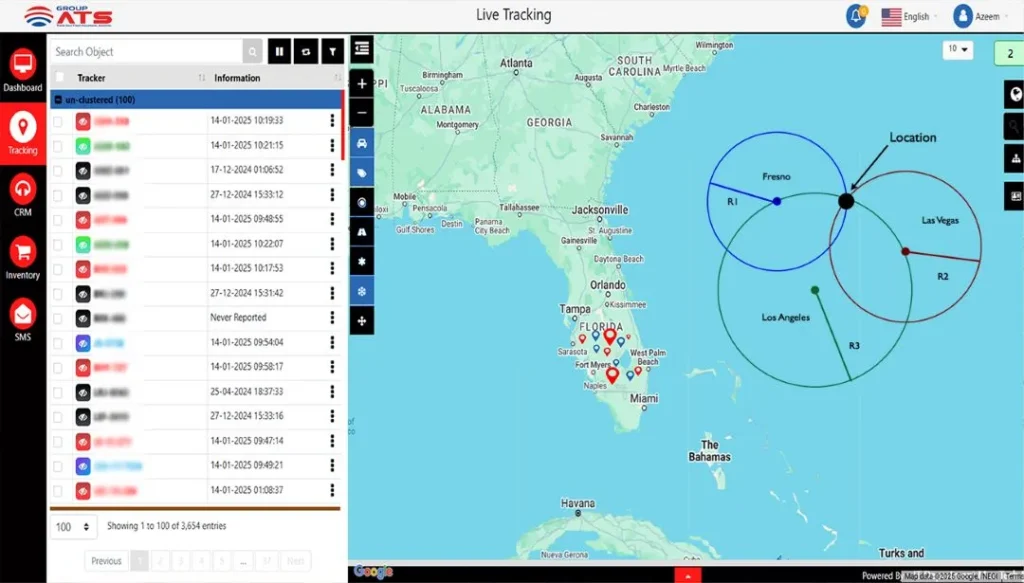Understand Tracking System: How Do GPS Trackers Work?
Have you ever lost track of the route that resulted in late deliveries? In today’s technological world, almost everyone has experienced a GPS tracker. These days, everyone seems to have GPS navigation, be it in their cars or smartphones. The technology, initially designed to pinpoint a vehicle or individual with a great deal of accuracy, aids drivers in getting to their destination with great speed. Not only this, but integrating such a system with the telematics solutions results in more advanced features and functionalities.
Global Positioning System is a helpful technology that is used in fleet operations, transportation, K-12 buses, logistics, and many other areas for better insight and visibility. The days of losing track, delayed deliveries, and maintenance issues are no more a problem. Advanced GPS in cars is an ultimate solution that protects your cars and provides better insight.
What Is A GPS?
GPS, or Global Positioning System, is a technology owned by the US Government. It is a satellite system that was initiated years ago for military use only. Its working includes satellites, receivers, trilateration, and accuracy. A constellation of 24 satellites is used in it, including the 6 Earth-centered orbital planes. Its key components include space, control, and user segment. Its applications in navigation, tracking, mapping, timing, and other areas make it a widely used technology.
What Is A GPS Tracker?
Still, many are not aware of what GPS trackers truly are and how they work.
A GPS tracker is a device used for location tracking, be it a vehicle, a person, or any object. These devices, once installed within your vehicle, start tracking your automobile’s location. Besides this, advancements in technology resulted in clearer and accurate tracking features. Telematics integration provides detailed insight like idling, over-speeding, movement, stop points, ETA, and many more.
You are also given access to its relevant mobile app to keep an eye on your valuables 24/7. These devices come in various types: portable, wireless, wired, and mini GPS trackers.
History Behind The GPS Tracking System
GPS, also at that time known as the NavStar GPS, was developed during the era of 1960s and hence was expected to be used for military purposes. Tracking submarines carrying nuclear missiles was its sole purpose. The submarine’s location was simply tracked using the six satellites in space. After that, in 1978, there was a first-time launch of a Navigation System With Timings And Ranging, NAVATSAR.
It was introduced to civilians on September 16, 1983. A fully developed, 24-satellite system was introduced in 1993. Now, in today’s world, there a 31 GPS satellites operated by the US as part of the GNSS.
Get certified, Stay Compliant!
Contact us for your GPS tracker certificates.
Steps on How Does GPS Tracking System Works?
The working of a GPS tracker is a straightforward process. All it needs are the satellites orbiting the Earth.
1. Signal Reception
- Different satellites are orbiting the Earth. Each satellite transmits a signal to the GPS receiver within the tracker.
- The built-in receiver in these trackers listens to the signals that are sent from the GPS satellite.
- Each tracker needs at least 4 satellite signals to pinpoint the accurate location.
- The signals transmitted to the receiver include the time and location at which they are sent.
2. Triangulation Step

- Once a GPS satellite sends the signal to a receiver, it starts calculating the time at which the signal was received.
- Despite this, four satellite signals are plenty since the more signals there are, the more accurate the location.
- By understanding the distance from each satellite, a tracker can determine its position using a method known as Trilateration.
3. Location Calculation

- Once the tracker calculates the total time and distance of a signal, it starts comparing that to the known position of a satellite.
- Then it calculates the coordinates like latitude, longitude, and altitude.
- A complex mathematical equation, like the speed of light and the location of the satellite, is used in this step.
4. Data Transmission

Once the data is calculated, GPS sends this data to a server or an application. There are different communication methods for it.
- The GPS sends the location data to a cellular network like a mobile app.
- In remote areas, satellite-based communication is used by the trackers.
- Data is also sent to the nearby device through Bluetooth.
5. Display Or Tracking
- The data is processed for future use after it is submitted to the server.
- After processing, it is then displayed on the mobile app or web software in a map interface.
- It includes data like location, speed, movement directions, and more.
- You can use the web program or mobile app to track your car’s movements in real time, around-the-clock.
Now, with the help of telematics, there are many more features that you can get.
6. Additional Features With Telematics

There are some additional features that you get with telematics integration. These features include:
- It offers an opportunity to set virtual boundaries and restrict the vehicles from entering these zones.
- It gives accurate data for your vehicle speed, movement, status, and location.
- It allows you to set custom alerts according to your needs, whether fuel, idling, overspeeding, or battery unplug.
- You can also get custom reports for any time of the year, whether weekly, daily, monthly, or annually.
How Do Trackers Work For Fleet Management?
It might be clear how GPS tracking devices work. These devices are not only helpful for your vehicles, but they are also a technology used by transportation companies in major countries like the USA, UAE, and more. These devices help in compliance with the regulations and ensure safety throughout the supply chain.
- It helps the fleet managers know the accurate location and provide a precise ETA to the customers. It results in gaining their trust.
- It helps the owners determine better routes that result in lower fuel consumption and timely deliveries.
- It gives accurate mileage data for the total distance a vehicle has driven per mile and its fuel consumption.
- It restricts vehicle entry into the restricted zone and promotes safety.
- It assists management in monitoring driver conduct and minimizing reckless driving.
Adding GPS to your car has a lot of additional advantages. Using these trackers helps you improve business profitability.
Monitor Your Fleet With GPS!
GPS is a tech advancement that has simplified transportation and fleet management. It is a helpful technology that helps to monitor the different KPIs of the fleet. Whether you want to know vehicle location, geofencing report, maintenance, or anything else, it helps you in every aspect. There was a time when it was used only for military purposes; later on, its need for civilian use rose. After that, tech advancements enhanced its features. If you are willing to know how do GPS trackers work, then have a look at this helpful guide. Know about its working, benefits, and history.
FAQ’s
Yes, having a mobile and a SIM card is mandatory to get GPS data.
No, the GPS tracker does not require internet connectivity.
There is no specific limit because these trackers are limitless on the earth.

